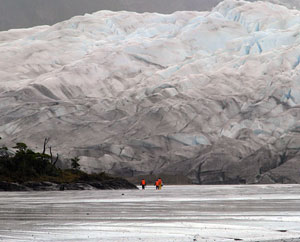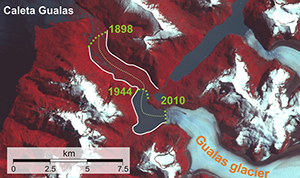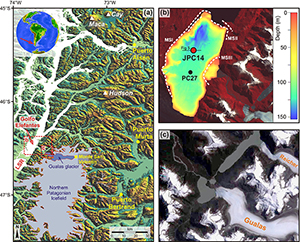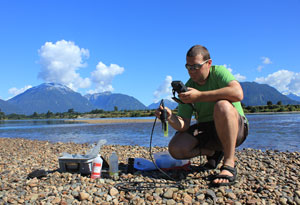 |
 |  |
 |
|
Enlarge Image
A team of researchers led by WHOI scientist Sébastien Bertrand took sediment samples from fjords in Chilean Patagonia to investigate how and why the Gualas Glacier has been retreating. (Photo courtesy of Dr. Claudia Silva) |
 |
 |  |
 |
|
Enlarge Image
The positions of the Gualas Glacier in 1898 and 1944 are superimposed on a false color satellite image showing the glacier in 2010. (S. Bertrand et al.: Neoglacial fluctuations of Gualas glacier, Climate of the Past) |
 |
 |  |
 |
|
Enlarge Image
Maps of Gualas Glacier and Golfo Elefantes, an outlet fjord for glacial meltwater from the glacier, in Northern Chilean Patagonia. (S. Bertrand et al.: Neoglacial fluctuations of Gualas glacier, Climate of the Past ) |
 |
 |  |
 |
|
Enlarge Image
WHOI postdoctoral fellow Sébastien Bertrand is at work on a project to assess how rapidly melting glaciers are transferring chemical elements from land to the coastal ocean and how these affect the health of downstream aquatic environments and people who depend on them. (Photo courtesy of Zakaria Ghazoui, Renard Centre of Marine Geology, University of Ghent, Belgium) |
 |
 | Related Links |
 |
|
Like many mountain glaciers, the Gualas Glacier in the Patagonian region of Chile has retreated fast during the past century in the face of climate change. But not only for the reason you’d first suspect.
The glacier’s retreat—5.5 miles over the past 110 years and 1.7 miles in the past 25 years—is not just being driven by melting caused by warming air temperatures. Instead, less snow is falling atop the glacier to replenish the river of ice flowing to the sea.
An international research team led by Sébastien Bertrand, a postdoctoral scientist at Woods Hole Oceanographic Institution (WHOI) and the University of Ghent, came to this surprising conclusion after extensive geological and historical detective work. The scientists extracted a 50-foot-long core of sediments that had settled on the seafloor after being bulldozed by the glacier into a fjord over the past 5,400 years. They painstakingly analyzed the sizes of particles and the concentrations of chemical elements in the sediments—evidence they used to reconstruct when the glacier had advanced and retreated.
The researchers then compared their glacial timeline with other records from nearby fjords and lakes not affected by the glacier’s runoff. Organic compounds preserved in fjord sediments provided a record of past ocean temperatures. Pollen counts in lake sediments indicated times when vegetation, and therefore precipitation, had changed in the past. Collating all the data, the scientists discovered that the glacier shifts corresponded with trends in precipitation levels, not with temperature changes.
The study, published in March 2012 in the journal Climate of the Past, also incorporated research by Fernando Torrejón, a historian with the University of Concepción (Chile). He plumbed historical observations of early Spanish explorers, which confirmed the interpretation of the geological/sediment record.
The Gualas Glacier, now 20 miles long with an area of 46 square miles, is one of 70 glaciers in the Northern Patagonian Icefield. The glaciers are fed by water that originates in the Pacific Ocean and is transported by westerly winds. The moist air hits the Andes Mountains and drops up to 33 feet of precipitation a year on the west side of the mountains.
The majority of these glaciers on the Andes’ western flanks have retreated over the past 150 years, mostly because snow-bearing westerly winds have weakened—a result of climate change, Bertrand said. On the eastern, or leeward, flank of the icefield, however, glaciers may be more affected by rising temperatures, he said.
Understanding the fate of glaciers is not merely an academic exercise. Glaciers hold frozen water that otherwise would raise sea levels, and they are also a key source of water for drinking and agriculture for people in many parts of the world.
Bertrand wants to investigate whether scientists can use fjord sediments to reconstruct glacial histories in other places around the globe and whether shifting snowfall patterns may be affecting glaciers in Alaska, Greenland, and New Zealand.
This research was supported by a European Union Marie Curie Outgoing International Fellowship, the U.S. National Science Foundation, and a Chilean National Oceanographic Committee grant.
Posted: November 20, 2012
|